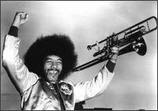Selucky did historical research on famous cowgirls along side modern, journalistic research on female ranchers today. Her structure is confusing because it is too simple. She spends the entire first half of the article talking about historical figures, and the rest of the article discussing modern day cowgirls and nothing else. The only connection between these two groups is an awkward transitory paragraph:
For years to follow, more and more women competed in rodeo events, often wining prize money that allowed them to independently support themselves. They helped make rodeo a popular sport in the U.S., with events from Monterey County to Madison Square Garden, providing a link from ranching past to present. Today, the Women's Professional Rodeo Association has more than 2,000 members, sanctions over 800 women-only races, and awards prize money nearing $4 million annually.
This transition mentions modern rodeo for the first time, three pages into the article. The rest of the piece briefly touches upon three modern "cowgirls," though we aren't really given any notion of who they are or what they actually do on a daily basis. There is a dearth of quotes, and no evidence that the author spent a significant amount of time with her interview subjects. The candid opinion to information ratio is very high, which demonstrates the author's inability to show rather than tell. "It's as if the term "cowgirl" has been hijacked," says Selucky, "so that we can't even recognize a real cowgirl when we see one."
Terry: why is this important? Are the women ranchers you interviewed really sore about people calling them "ranchers" instead of "cowgirls"? If they are, perhaps you should quote them. The entire last page of the article melts into a giant blob of opinions veiled by "perhaps" and "consider the fact..."
The article would be far more engaging if it focused on modern day ranch women and touched on historical examples throughout. Selucky opens with a historical and shocking anecdote about the lynching of a cowgirl in 1889. The anecdote is completely incongruous with the rest of the article, and could easily have been replaced with a modern anecdote. The feminist message of the piece wouldn't be lost if Selucky limited her righteous interjections; in fact, the message would be more powerful if the article actually did justice to the complex lives and ideas of women ranchers in modern America.

No comments:
Post a Comment